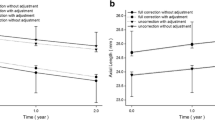Summary
Myopia is the most common visually significant error, with a prevalence of 25–30% in the general population. As the number of myopic patients is growing it should also be considered as a health care and socioeconomical problem. The exact mechanism for the development of myopia is not fully understood. Genetical factors, as well as prolonged nearwork and an accommodative lag were discussed to play a role in the development of myopia. Many studies investigated therapeutical strategies for inhibition of myopia progression in children: optical interventions like over- or undercorrection with glasses or use of contact lenses did not show promising results; with bifocal glasses a small, but clinically not relevant difference in myopia progression could be detected. Pharmacological treatment with antimuscarinic substances combined with bifocal glasses showed a significant delay in myopia progression in the treated group; however due to side-effects and missing data of long-term studies these interventions can not be recommended for a broad clinical application up to now.
Zusammenfassung
Myopie ist mit einer Prävalenz von 25–30 % der Gesamtpopulation der häufigste Refraktionsfehler des Auges. Mit der ständig steigenden Zahl betroffener Patienten gehen auch zunehmend gesundheitliche aber auch wirtschaftliche Probleme einher, weshalb intensiv an der noch nicht restlos geklärten Ursache der Entstehung der Myopie geforscht wird. Als beteiligte pathogenetische Faktoren wurden bisher genetische Prädisposition, intensive Naharbeit in der Jugend, sowie eine Form von Akkommodations-trägheit diskutiert. Um die Progression der Myopie zu hemmen wurden einige therapeutische Maßnahmen in Studien an Kindern und Jugendlichen untersucht: bei den optischen Interventionen wie Über- bzw. Unterkorrektur oder Tragen von Kontaktlinsen zeigte sich keine Progressionshemmung; das Tragen von Gleitsichtgläsern zeigte nur einen geringen, nicht klinisch relevanten positiven Effekt. Auch die pharmakologische Behandlung mit antimuscarinergen Substanzen zusammen mit Bifokalgläsern zeigte eine signifikante Verlangsamung der Progression bei den behandelten Kindern, auf Grund von Nebenwirkungen und noch unzureichender Daten bezüglich der Risiken bei längerer Anwendungsdauer ist man jedoch noch weit von einer Anwendung im klinischen Routinebetrieb entfernt.
Similar content being viewed by others
Referenzen
Sperduto RD, Seigel D, Roberts J, Rowland M (1983) Prevalence of myopia in the United States. Arch Ophthalmol 101(3): 405–407
Lin LL, Chen CJ, Hung PT, Ko LS (1988) Nation-wide survey of myopia among schoolchildren in Taiwan, 1986. Acta Ophthalmol [Suppl] 185: 29–33
Javitt JC, Chiang YP (1994) The socioeconomic aspects of laser refractive surgery. Arch Ophthalmol 112(12): 1526–1530
Morgan RW, Munro M (1973) Refractive problems in Northern natives. Can J Ophthalmol 8(2): 226–228
Rosner M, Belkin M (1987) Intelligence, education, and myopia in males. Arch Ophthalmol 105(11): 1508–1511
Zylbermann R, Landau D, Berson D (1993) The influence of study habits on myopia in Jewish teenagers. J Pediatr Ophthalmol Strabismus 30(5): 319–322
Familial aggregation and prevalence of myopia in the Framingham Offspring Eye Study. The Framingham Offspring Eye Study Group. Arch Ophthalmol (1996) 114(3): 326–332
Midelfart A, Aamo B, Sjohaug KA, Dysthe BE (1992) Myopia among medical students in Norway. Acta Ophthalmol (Copenh) 70(3): 317–322
Zadnik K, Mutti DO (1987) Refractive error changes in law students. Am J Optom Physiol Opt 64(7): 558–561
Schaeffel F, Glasser A, Howland HC (1988) Accommodation, refractive error and eye growth in chickens. Vision Res 28(5): 639–57
Wallman J, Turkel J, Trachtman J (1978) Extreme myopia produced by modest change in early visual experience. Science 201(4362): 1249–1251
Wallman J, Wildsoet C, Xu A, et al (1995) Moving the retina: choroidal modulation of refractive state. Vision Res 35(1): 37–50
Drexler W, Findl O, Schmetterer L, et al (1998) Eye elongation during accommodation in humans: differences between emmetropes and myopes. Invest Ophthalmol Vis Sci 39(11): 2140–2147
Gwiazda J, Thorn F, Bauer J, Held R (1993) Myopic children show insufficient accommodative response to blur. Invest Ophthalmol Vis Sci 34(3): 690–694
Mutti DO, Mitchell GL, Moeschberger ML, et al (2002) Parental myopia, near work, school achievement, and children's refractive error. Invest Ophthalmol Vis Sci 43(12): 3633–3640
Chung K, Mohidin N, O'Leary DJ (2002) Undercorrection of myopia enhances rather than inhibits myopia progression. Vision Res 42(22): 2555–2559
Gwiazda J, Hyman L, Hussein M, et al (2003) A randomized clinical trial of progressive addition lenses versus single vision lenses on the progression of myopia in children. Invest Ophthalmol Vis Sci 44(4): 1492–1500
Walline JJ, Jones LA, Mutti DO, Zadnik K (2004) A randomized trial of the effects of rigid contact lenses on myopia progression. Arch Ophthalmol 122(12): 1760–1766
Stone RA, Lin T, Laties AM (1991) Muscarinic antagonist effects on experimental chick myopia. Exp Eye Res 52(6): 755–758
Shih YF, Chen CH, Chou AC, et al (1999) Effects of different concentrations of atropine on controlling myopia in myopic children. J Ocul Pharmacol Ther 15(1): 85–90
Shih YF, Hsiao CK, Chen CJ, et al (2001) An intervention trial on efficacy of atropine and multi-focal glasses in controlling myopic progression. Acta Ophthalmol Scand 79(3): 233–236
Yen MY, Liu JH, Kao SC, Shiao CH (1989) Comparison of the effect of atropine and cyclopentolate on myopia. Ann Ophthalmol 21(5): 180–182, 7
Tan DT, Lam DS, Chua WH, et al (2005) One-year multicenter, double- masked, placebo-controlled, parallel safety and efficacy study of 2% pirenzepine ophthalmic gel in children with myopia. Ophthalmology 112(1): 84–91
Author information
Authors and Affiliations
Corresponding author
Rights and permissions
About this article
Cite this article
Leydolt, C., Findl, O. Myopie: Prävention und Progressionshemmung. Spektrum Augenheilkd. 21, 294–296 (2007). https://doi.org/10.1007/s00717-007-0227-8
Published:
Issue Date:
DOI: https://doi.org/10.1007/s00717-007-0227-8




